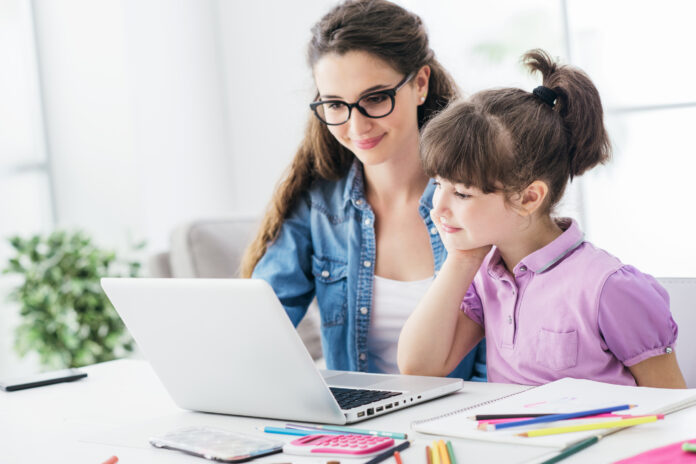Sandra Kim, a resident of Loudoun County, Virginia, started homeschooling her three children in the summer of 2020.
She doesn’t necessarily have a problem with public schools, Kim says, but realized her children could do more.
Her second grader now is doing higher-level math and her fourth grader is writing essays, which normally wouldn’t have happened until sixth grade.
“Homeschoolers also do really well in college because they learn executive functioning skills from being at home,” Kim says.
Kim, the media relations director of the Home School Legal Defense Association, has documented her homeschooling experiences with her husband, John Yesawich.
He originally was less open to homeschooling, but had a change of heart upon seeing the many benefits—mainly family time, efficiency, and effectiveness.
After looking at what his kids were doing in school and experiencing the fatigue of having to navigate logging them in to remote learning under COVID-19 guidelines, Yesawich recalls concluding, “I think we can do better than this.”
“Not to set the bar too low, but I’m surprised they’re learning,” he says, as shown in a video produced by Home School Legal Defense Association.
“They’re learning a lot. … I think as a parent, having never done it, you’re worried about that. So I’m surprised. They’re learning something.”
‘Let’s Find Out’
Kim says it’s been humbling teaching their children because she realizes she does not know as much as she thought.
“One of my biggest surprises is how much I’m learning,” Kim says.
She provides an example of her son, a third grader, asking her if a shell grows. “There’s a lot of ‘Let’s find out.’”
Jube Dankworth, CEO of Texas HOME Educators, says it’s typical for parents to learn along the way. Established in 2007, the group, whose name includes an acronym for Helping Other Members Educate, is a homeschool community based in southeast Texas.
“Homeschooling isn’t just books and support. It’s a relationship with your child,” Dankworth says. “It’s learning together with your child. One of the things I hear over and over from the moms is ‘I was never taught this. I just found out.’ That’s particularly the case when it comes to history.”
Kim and Yesawich, who both work full time, say that being homeschooling parents isn’t easy but is worth it. They say they’ll continue homeschooling even after the COVID-19 pandemic is past.
“I’m a product of public school and we chose it for our kids,” Kim says. “But after having [the] opportunity to homeschool, I can’t imagine going back.”
Parents Not Alone
Kim and Yesawich are just one example among millions of parents who have decided to continue homeschooling their children.
About 5.4% of American households reported moving to homeschooling when public schools closed in the spring of 2020.
That number jumped to 11.1% in fall 2020, compared to the typical pre-pandemic level of 3.3%, according to the U.S. Census Bureau.
These statistics account for true homeschooling rather than online virtual learning from a remote location through a public or private school.
State officials and homeschooling associations continue to report increases in families who choose to educate their children at home following the sharp jump seen in 2020, says Jonathan Butcher, the Will Skillman fellow in education at The Heritage Foundation. (The Daily Signal is the multimedia news outlet of The Heritage Foundation.)
Michael Donnelly, father of seven and senior counsel of the Home School Legal Defense Association, says homeschooling is growing in all states and among Americans of all races and ethnicities, including traditionally underrepresented populations in homeschooling such as blacks, Hispanics, and Asians.
“There’s been some stickiness to homeschooling,” Donnelly says. “Membership numbers are staying high and curriculum companies are saying their sales numbers are staying high.”
“There are very low barriers to entry for homeschooling for parents who want to do it,” he adds.
Texas in Lead
States that have seen the biggest increases in homeschooling are Alaska, Florida, Vermont, Oklahoma, and Mississippi, in that order, according to the Census Bureau.
Homeschooling in Texas nearly doubled after the COVID-19 pandemic began, producing the highest number of homeschooled children of any state. (In California, many families are using a public-school curriculum at home, so Texas took the lead.)
Texas also has relatively lax laws covering homeschooling. In 1891, a U.S. Supreme Court case known as Leeper v. State of Texas determined that a homeschool counts as a private school, and the Texas Legislature doesn’t regulate private schools.
Dankworth says her own four daughters attended Maranatha Academy, a name that her husband chose from Hal Lindsey’s 1970 bestselling book “The Late Great Planet Earth.” (Maranatha is an Aramaic phrase translated as “Come, our Lord.”)
Many homeschooling families choose their own school colors, motto, and mascot. Maranatha’s mascot was a dove, Dankworth says, and the school colors are blue and gold.
Texas resident Kylie Compton says her children, 13 and 15, follow author-educator Oliver DeMille’s Thomas Jefferson Education approach.
“In Texas, we have so much freedom to pick what type of philosophy we want to use to educate children because [there] aren’t any rules … about specific curriculum or types of things you have to do,” Compton says, naming a wide range of homeschooling methods and options.
One method is called “unschooling,” or child-led learning facilitated by parents, which Dankworth says is more common in younger age groups.
“There’s this free-market idea to homeschooling, which is completely individualizable to parents, families, and kids,” the Home School Legal Defense Association’s Donnelly says.
‘Communicate What We Value’
Donnelly says he likes the fact that his children have the freedom to do their schoolwork at the kitchen table, on the couch, or on the living room floor.
He and his wife have homeschooled their seven children for 20 years, Donnelly says, and they find it relatively stress-free and conducive to learning.
He did well in public school, Donnelly says, but as a father didn’t want to put his kids on a yellow bus to go somewhere else for eight hours a day.
“When do we get to be a family?” he asks. “We want to communicate what we value to our children.”
During the pandemic, education co-ops have increased as a way to supplement homeschooling. Co-ops are groups of homeschooling families who get together once or more per week to either teach their children in group classes or to partake in group activities like field trips for socialization.
Kim and her husband are part of two co-ops. One, called Teaching and Training, meets one day a week for four hours.
“They just finished up Greeks and Romans; they just had Olympics; the older kids put on a play about the Pandora myth,” Kim says. “Now they are in human anatomy.”
In the other co-op, their children are studying a different country each week and preparing food associated with that country.
“I really think that people need to realize you’re not off on the prairie somewhere,” Kim says.
Originally published by The Daily Signal. Republished with permission.










